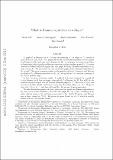What is Ramsey-equivalent to a clique?
Author(s)
Liebenau, Anita; Person, Yury; Szabó, Tibor; Fox, Jacob; Grinshpun, Andrey Vadim
DownloadFox_What is.pdf (382.3Kb)
PUBLISHER_CC
Publisher with Creative Commons License
Creative Commons Attribution
Terms of use
Metadata
Show full item recordAbstract
A graph G is Ramsey for H if every two-colouring of the edges of G contains a monochromatic copy of H. Two graphs H and H′ are Ramsey-equivalent if every graph G is Ramsey for H if and only if it is Ramsey for H′. In this paper, we study the problem of determining which graphs are Ramsey-equivalent to the complete graph K[subscript k]. A famous theorem of Nešetřil and Rödl implies that any graph H which is Ramsey-equivalent to K[subscript k] must contain K[subscript k]. We prove that the only connected graph which is Ramsey-equivalent to K[subscript k] is itself. This gives a negative answer to the question of Szabó, Zumstein, and Zürcher on whether K[subscript k] is Ramsey-equivalent to K[subscript k]⋅K[subscript 2], the graph on k+1 vertices consisting of K[subscript k] with a pendent edge.
In fact, we prove a stronger result. A graph G is Ramsey minimal for a graph H if it is Ramsey for H but no proper subgraph of G is Ramsey for H. Let s(H) be the smallest minimum degree over all Ramsey minimal graphs for H . The study of s(H) was introduced by Burr, Erdős, and Lovász, where they show that s(K[subscript k])=(k−1)[superscript 2]. We prove that s(K[subscript k]⋅K[subscript 2])=k−1, and hence K[subscript k] and K[subscript k]⋅K[subscript 2] are not Ramsey-equivalent.
We also address the question of which non-connected graphs are Ramsey-equivalent to K[subscript k]. Let f(k,t) be the maximum f such that the graph H=K[subscript k]+fK[subscript t], consisting of K[subscript k] and f disjoint copies of K[subscript t], is Ramsey-equivalent to K[subscript k]. Szabó, Zumstein, and Zürcher gave a lower bound on f(k,t). We prove an upper bound on f(k,t) which is roughly within a factor 2 of the lower bound.
Date issued
2014-07Department
Massachusetts Institute of Technology. Department of MathematicsJournal
Journal of Combinatorial Theory, Series B
Publisher
Elsevier
Citation
Fox, Jacob et al. “What Is Ramsey-Equivalent to a Clique?” Journal of Combinatorial Theory, Series B 109 (2014): 120–133.
Version: Original manuscript
ISSN
00958956